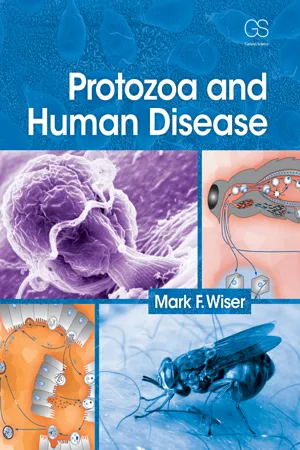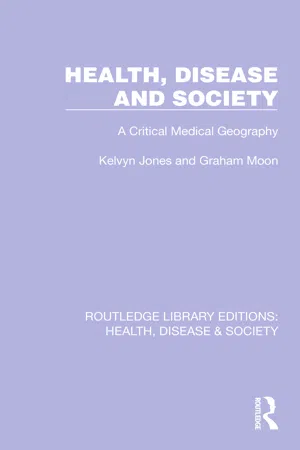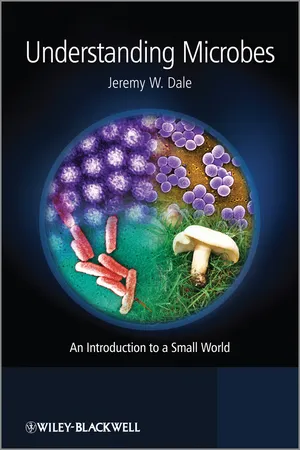Biological Sciences
Protist Diseases
Protist diseases are caused by single-celled eukaryotic organisms that can infect humans, animals, and plants. These diseases can range from mild to severe and can be transmitted through various means such as contaminated water or food, insect bites, or direct contact with infected individuals. Some examples of protist diseases include malaria, toxoplasmosis, and giardiasis.
Written by Perlego with AI-assistance
Related key terms
Related key terms
1 of 4
Related key terms
1 of 3
3 Key excerpts on "Protist Diseases"
- eBook - ePub
- Mark F Wiser(Author)
- 2010(Publication Date)
- Garland Science(Publisher)
1 Introduction to Medical Protozoology Many important human and animal diseases are caused by protozoan pathogens (Table 1.1). These diseases impact humans directly in terms of morbidity and mortality as well as having a major impact on agriculture. In addition to being known parasites, some protozoa are considered opportunistic pathogens that primarily affect immunocompromised individuals. In many parts of the world diseases caused by protozoa are on the rise and thus considered as emerging or re-emerging diseases. In addition, these diseases are often neglected because they are found predominantly in developing countries. A wide range of disease manifestations are exhibited by protozoan pathogens reflecting the variety of organs and tissues affected. Most protozoan infections are acquired through the ingestion of specialized infective stages and several protozoan species are transmitted by arthropod vectors. What Are Protozoa? Protozoa are not easily defined because they are diverse and are often only distantly related to each other (Figure 1.1). Furthermore, many protozoa exhibit similarities to other eukaryotes and the classification of protozoa is often controversial. Because of the extreme diversity of the protozoa the only feature common to all protozoa is that they are unicellular eukaryotic microorganisms. Thus, protozoa possess typical eukaryotic organelles and in general exhibit the typical features of other eukaryotic cells. For example, a membrane-bound nucleus containing the chromosomes is found in all protozoan species. However, in many protozoan species some of the organelles may be absent, or are morphologically or functionally different from those found in other eukaryotes - eBook - ePub
Health, Disease and Society
A Critical Medical Geography
- Kelvyn Jones, Graham Moon(Authors)
- 2022(Publication Date)
- Routledge(Publisher)
This chapter is concerned with diseases that are capable of being transmitted from someone who is infected (the host) to someone who has not yet had the disease (the susceptible); they are variously known as contagious, infectious and communicable diseases. In the industrialised countries, despite the recent threat of AIDS, they are generally of low importance; even in childhood, communicable diseases are a minor cause of suffering and morbidity and now cause less than 5 per cent of all childhood deaths in Britain. Historically, they have been of much greater importance; only forty years ago tuberculosis was the disease of civilisation, and in the economically backward countries they remain the major killers today. Communicable diseases are given a separate chapter here because of this worldwide importance (two-thirds of all human illness is attributed to such causes), and because their fundamentally different disease processes, when compared to chronic and degenerative diseases, require different modes of analysis. The discussion begins with a brief introduction to the biology of the diseases and then the different research traditions of ‘disease ecology’ and ‘diffusion’ studies are outlined and illustrated. As the discussion proceeds we move away from the biomedical model towards a social, and arguably deeper, understanding of communicable diseases.The biology of infectious diseases
Communicable diseases have a bewildering diversity and it is wise at the outset to offer a classification. It is possible to produce a classification on a number of criteria (for example, portal of entry and exit of infectious agent) but a classification based on the various types of organisms and their differing means of transmission is most appropriate for our purposes.Organisms
There are six basic groups of organisms (Open University, 1985b ).- Viruses are chains of nucleic acid surrounded by a protein coat; they cannot reproduce themselves without entering the cells of plants or animals. They produce such diseases as influenza, measles (rubella), rabies, herpes, smallpox, encephalitis, yellow fever, dengue fever and German measles.
- Bacteria are true cells but have no nucleus. One example is tetanus which secretes a toxin which is taken up by the nerve endings and disrupts the nerves to the spinal cord and the brain, thereby producing an intense muscular spasm; hence the term ‘lockjaw’. Other bacterial diseases include diphtheria, pneumonia, sinusitis, botulism, gonorrhoea, typhoid, cholera, whooping cough (pertussis), yaws, syphilis and dental caries.
- Fungi produce diseases such as ‘thrush’ which results in an intense itching in the vagina, and ringworm, a skin disease which is most prevalent among children.
- Protozoa are single-celled organisms which are able to change their shape and are generally bigger than bacteria. Plasmodia produce malaria, while Trypanasoma results in sleeping sickness which currently affects an estimated 40 million people.
- Insects such as ticks and mites are multicellular organisms.
- Helminths are also multicellular organisms and they often have a complicated lifecycle. Examples include hookworms, which attack the wall of the intestine and feed off blood, thereby producing anaemia in the host, and the Ascaris
- eBook - ePub
Understanding Microbes
An Introduction to a Small World
- Jeremy W. Dale(Author)
- 2012(Publication Date)
- Wiley-Blackwell(Publisher)
Effective treatments against malaria are also limited. As we will see in Chapter 4, antibacterial antibiotics rely on the fact that bacteria are different in many respects from human cells. Thus, there are ways to kill bacteria without killing our own cells as well. However, Plasmodia are protozoa, which are eukaryotic and therefore much more similar to human cells, making it more difficult to kill them safely.There are several drugs that are effective, but not so many – and therein lies a problem. If we use one drug all the time then, sooner or later, the organism will become resistant. In other words, we are applying a very strong selective pressure, so that any mutations that lead to resistance – even if they happen only very rarely – will rapidly take over, and that drug becomes ineffective. I will look further at the drugs available for treating malaria in the next chapter.3.2 Diseases of the Present
So, we have seen that, in the UK and similar countries, many of the diseases that historically were major killers are now diseases of the past – but we should never forget that many of these diseases are still a serious problem for the majority of the world. However, we are still faced with a number of important infectious diseases, which we can consider in three categories:- diseases which have always been with us, although they may not be historically as important as those already considered;
- ‘opportunist’ infections, which take advantage of the ability of modern medicine to keep alive people with serious conditions that affect their resistance to infection;
- ‘new’ diseases (the so-called ‘emerging infections’) – although, as we will see, some of them are not really new, only newly recognized.
We can consider influenza as an example of a disease under the first heading. During an epidemic, a large number of people die, either of flu itself or, more often, of secondary infections that take advantage of the effect that flu has on our resistance to respiratory infections. However, the number of deaths is usually small in relation to the enormous number of cases, and most people recover quickly. Nevertheless, it is of considerable economic importance, not only because of the cost to our health services, but also because of the number of days of work lost during an epidemic.
Index pages curate the most relevant extracts from our library of academic textbooks. They’ve been created using an in-house natural language model (NLM), each adding context and meaning to key research topics.
Explore more topic indexes
Explore more topic indexes
1 of 6
Explore more topic indexes
1 of 4


